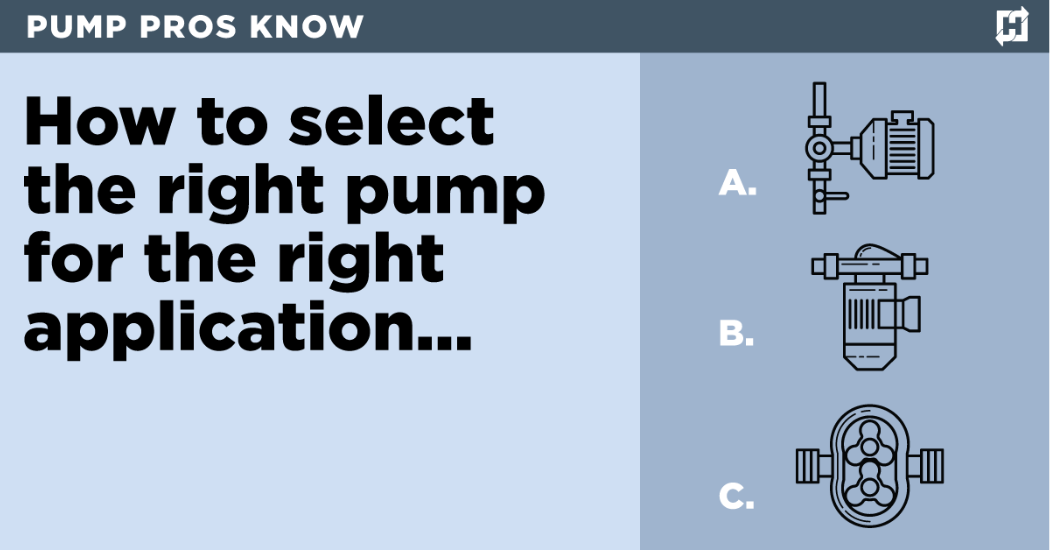The following overview is not intended as a selection guide. Rather, its objective is to outline a few of the many variables to be considered in selecting a specific pump for a given application.
Pumps come in a surprisingly wide range of sizes and types — from tiny medical pumps for individuals to giant pumps for municipal water supplies. But when faced with the challenge of selecting a pump for a particular application, much more needs to be considered than just size and type.
The one characteristic all pumps share is that they move a liquid from one location to another. The liquid may be clean water or water-like, viscous, or include slurries, organic or inorganic solids, and in some cases entrained gases. The pump design and selection will need to consider the liquid properties and anything entrained in the liquid.
The liquid properties may be such that it flows easily, such as water flowing down an incline from only the force of gravity. But a thick liquid — such as peanut butter or fresh concrete — may flow slowly or not at all unless a force greater than gravity acts on it. So the state of the fluid is a basic consideration in selecting a pump for an application.
Pumping mechanics
Of course, moving different liquids requires different types of pumps. A centrifugal pump is the most common type used. It includes and bladed impeller that rotates inside a collector with an opening for liquid to enter (the inlet port) and an opening at the opposite end for liquid to exit (the outlet, or discharge port). These types of pumps are most efficient when handling clean and non-viscous liquids due to the additional friction with the rotating impeller at higher viscosities.
Contrast this with a pump designed to move liquid concrete. This pump is used to move fresh concrete from a large tub containing concrete to a location far away. The concrete flows from the tub into the pump. The pump contains reciprocating piston(s), which draws the concrete in and pushes it out (similar to pumping air out of a bicycle air pump). This type of pump is a reciprocating positive displacement design. With every revolution of the shaft, a specific volume is displaced, and will move the viscous concrete more efficiently than a centrifugal pump could.
In the first example, the rotation of the centrifugal pump impeller increases the velocity of the liquid within it and the collector efficiently diffuses the velocity. If you were to block the outlet of the centrifugal pump, the impeller would continue to rotate, the pressure would increase to a certain maximum value, and the liquid flow rate would go to zero. Take caution that should not operate a centrifugal pump at zero flow because mechanical and hydraulic loads can be damaging, and all the power is being input to the volume of liquid contained in the pump, which can cause rapid temperature rise and vaporization of the liquid.
In the second example, if you block the outlet of the concrete pump, the piston will still push the cement to the pump’s discharge port. But because the discharge port is blocked, the concrete has nowhere to go, so the pressure will build until either mechanical failure of the pump or piping occurs or the motor overloads and fails. In contrast to the centrifugal pump, a positive displacement pump will need to have a pressure relief valve to avoid this potential overload condition.
The decision to specify a positive-displacement or centrifugal pump depends on the machine application. In general, centrifugal pumps are used over a wide range of flow rates and pressures. The type and size of the centrifugal pump will dictate the flow rate and the pumping pressure. For higher pressures, a multi-stage pump (impellers in series) may be required, and for high flow rates, the impeller may need to have two inlets or have a different impeller type that looks more like a boat propeller (axial flow pump). Typical examples are pressure-boosting pumps in high-rise buildings, circulating pumps, sewage pumps, chemical process and petroleum pumps, sump pumps, and countless others.
On the other hand, reciprocating positive-displacement pumps are generally used in applications requiring high pressure at relatively low flow rates, and applications that require precisely metered flow. Some examples include hydraulic systems, metering pumps that inject chemical solutions for wastewater treatment, and pumps used in food processing equipment.
Of course, exceptions to these trends abound. For example, many pumps in medical equipment have positive displacement. They operate at low pressure but provide a precise flow rate. In addition, many machines use both positive displacement and centrifugal pumps. An automated car wash, for example, may use positive-displacement pumps to blast caked-on dirt from car surfaces — especially wheels and undercarriage — while centrifugal pumps gently rinse dirty and soapy water from body surfaces.
Physical and Chemical Characteristics
Chemical characteristics and physical properties of anything entrained in the liquid will need to be considered in the pump selection, generally in the materials of construction and equipment designed to pass solids or resist wear. For example, because salt water is corrosive to many metals, close attention must be paid to the compatibility of the wetted materials. Other applications may have abrasive solids, that require a specifically designed pump made of hard materials.
Selection and Sizing
After evaluating all the liquid parameters and application requirements, the process of selecting and sizing a pump can begin.
Read more Pump Pro Knows articles from Hydraulic Institute.




